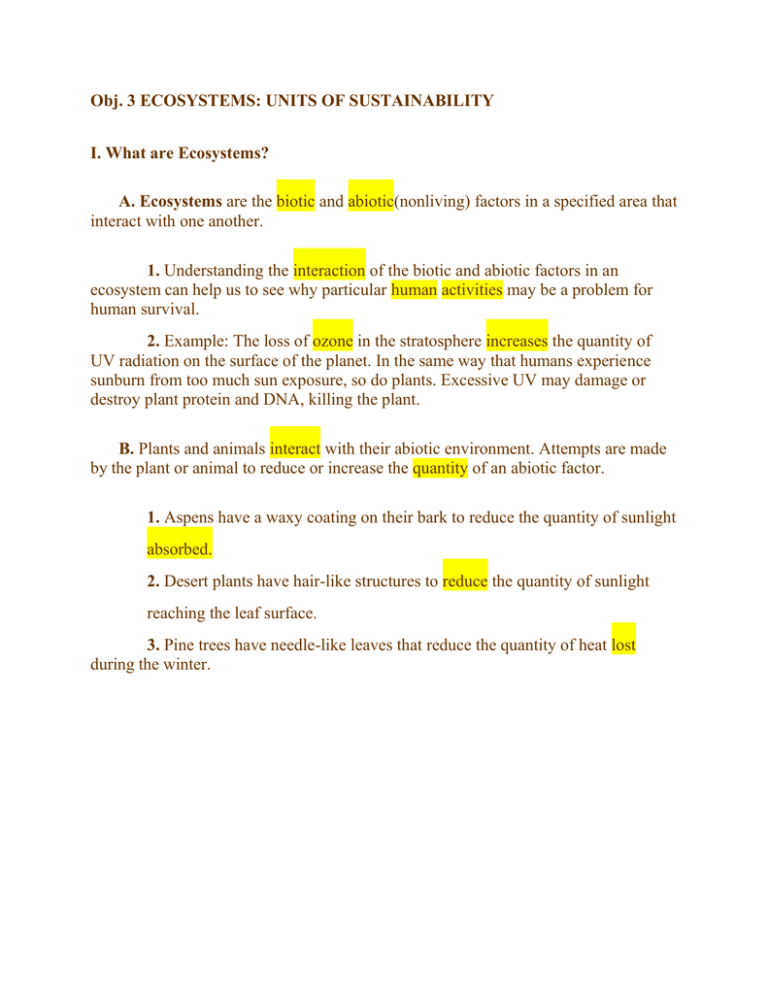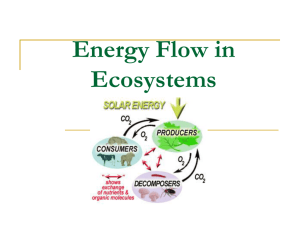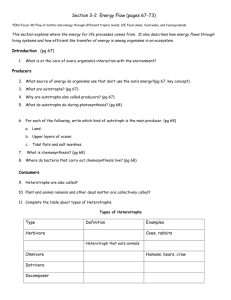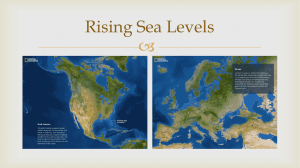Obj. 3 ECOSYSTEMS: UNITS OF SUSTAINABILITY I. What are Ecosystems? A. Ecosystems 1.
advertisement

Obj. 3 ECOSYSTEMS: UNITS OF SUSTAINABILITY I. What are Ecosystems? A. Ecosystems are the biotic and abiotic(nonliving) factors in a specified area that interact with one another. 1. Understanding the interaction of the biotic and abiotic factors in an ecosystem can help us to see why particular human activities may be a problem for human survival. 2. Example: The loss of ozone in the stratosphere increases the quantity of UV radiation on the surface of the planet. In the same way that humans experience sunburn from too much sun exposure, so do plants. Excessive UV may damage or destroy plant protein and DNA, killing the plant. B. Plants and animals interact with their abiotic environment. Attempts are made by the plant or animal to reduce or increase the quantity of an abiotic factor. 1. Aspens have a waxy coating on their bark to reduce the quantity of sunlight absorbed. 2. Desert plants have hair-like structures to reduce the quantity of sunlight reaching the leaf surface. 3. Pine trees have needle-like leaves that reduce the quantity of heat lost during the winter. Fig. 2.2 Ecosystems are not isolated from one another. One ecosystem blends into the next through a transitional region, an ecotone, which contains many species common to the two adjacent systems. Fig. 2.3 An ecotone may create a unique habitat with specialized species not found in either of the ecosystems bordering it. II. The Structure of Ecosystems. A. Feeding Relationships. 1. Trophic Categories. a. Producers create organic molecules proteins, lipids and carbohydrates- by capturing light energy and combining the captured energy with inorganic molecules. · Differentiate (tell the difference between) between organic and inorganic. · Differentiate between natural and synthetic. Fig. 2.4 The producers in all major ecosystems are green plants. b. Consumers feed on producers and would not exist without producers. · Primary consumers (herbivores)(plant eater) · Secondary consumers (carnivores)(eats primary consumers) · Omnivores are both herbivorous(eats plants)and carnivorous(eats animals). c. Detritus feeders and decomposers · Detritus feeders can be primary (feed directly on detritus-excrement) or secondary (feed on those who eat detritus). Generally detritus feeders can be described as those who consume dead plants and animals, feces, etc. · Decomposers are primary detritus feeders. Fig. 2.5 Water and the simple molecules found in air and in rocks and soils are inorganic(nonliving). The complex molecules that make up plant and animal tissues are organic (living or came from living things). Fig. 2.9 What an organism feeds on is described as a trophic relationship. Trophic types include producers and consumers. 2. Trophic Relationships: a. Food chains: feeding pathways · Food chains are a description of who eats whom. · Predator-prey and host-parasite describe specific feeding relationships. b. Food webs: complexes of feeding relationships. c. Trophic Levels or Feeding Levels · All producers belong to the first trophic level. · All herbivores (primary consumers) are on the second trophic level. · All primary carnivores (secondary consumers) are on the third trophic level. Fig. 2.12 A food web refers to all the trophic (feeding) connections among species within a community. Fig. 2.12 This figure shows trophic relationships within a marine community. 3. Biomass and Biomass Pyramid a. All organic matter can be defined as biomass. b. All biomass can be arranged into a feeding relationship with the producers on the first trophic level. c. On average, 10% of the energy from one trophic level moves to the next trophic level. (This is due partly to the First and Second Laws of thermodynamics.) At each trophic level most of the organisms are not consumed, portions of organisms consumed pass through the consumer undigested, and energy is released to the environment as high potential energy is converted to low potential energy. d. Because so little energy can be transferred between trophic levels, it is necessary that the first trophic level contain the greatest number of organisms, and the subsequent trophic levels contain fewer and fewer organisms. Limitations on the transfer of energy between trophic levels creates the biomass pyramid. e. If organisms (humans) eat high on the biomass pyramid (trophic levels 3, 4, 5, etc.), then fewer organisms can be supported than if organisms eat lower on the biomass pyramid. Fig. 2.13 This is a graphic representation of the biomass (total mass of organisms) at successive trophic levels has the form of a pyramid. Fig. 2.14 The movement of nutrients (blue arrows) and energy (red arrows) and both (brown arrows) through the ecosystem. B. Nonfeeding Relationships 1. Mutually Supportive Relationships: mutualism. 2. Competitive Relationships a. How are competitive relationships reduced? · Habitat · Niche: resource partitioning b. What happens when competition is not reduced? Competitive exclusion principle c. Abiotic factors. Fig. 2.17 Five species of North American warblers reduce the competition among themselves by feeding at different levels and on different parts of the trees. C. Limiting Factors A myriad of limiting factors define the viability of life. Basic items include temperature, light, oxygen, carbon dioxide, and precipitation. Only one limiting factor need be out of its optimum range to cause stress for an organism. 1. Optimum Levels a. Each factor necessary for survival has an ideal range. 2. Zones of Stress a. Each factor has a range of values that are above or below the ideal but not outside the range allowing survival. 3. Limits of Tolerance a. Each factor has an upper and a lower limit beyond which the organism cannot survive. 4. Range of Tolerance a. Each factor has a range of values that includes the zones of stress and the optimum levels. These values do not include the upper or lower limits beyond which the organism cannot survive. D. Law of Limiting Factors - Quantities of any single factor above or below optimum levels necessary for organism growth, reproduction, or survival will limit growth, reproduction, or survival. 1. Synergistic effects: The interaction of two or more factors cause an effect greater than the sum of effects produced when each factor acts alone. Fig. 2.18 For every factor influencing growth, reproduction, and survival, there is an optimum level. Above and below the optimum, there is increasing stress, until survival becomes impossible at the limits of tolerance. III.. Global Biomes A. The Role of Climate 1. Climate versus Weather a. Climate-the average temperature over time b. Weather-the daily variations in temperature and precipitation 2. Temperature and precipitation combine to create the world's biomes. 3. Describe how ecosystems change as temperature and precipitation change. a. Vary temperature while precipitation is held constant (Moderate rainfall: cold = cool desert, warmer = grassland) b. Vary precipitation while temperature is held constant (Cold temperature: little rain = tundra, more rain = cool desert, more rain = spruce/fir forest). Fig. 2.19 This map represents biomes of North America and South America. Fig. 2.19 This map represents biomes of Africa, Europe and Asia. B. Microclimate and Other Abiotic Factors 1. Light Intensity: south-facing versus north-facing hillside. 2. Soil Type a. pH b. Salinity c. Sand, clay, silt 3. Topography C. Biotic Factors 1. Shading of One Plant by Another 2. Chemical Produced by One Plant May Limit Growth of Another Plant 3. Presence of Herbivores tasty plants are consumed first. D. Physical Barriers Fig. 2.20 Moisture is generally the overriding factor determining the type of biome that may be supported in a region. Given adequate moisture, an area will generally support a forest. Temperature, however, determines the kind of forest. Fig. 2.21 Decreasing temperatures that result in the biome shifts occur both with increasing latitude (distance from the equator) and increasing altitude. Fig. 2.22 Abiotic factors such as terrain, wind, and type of soil create different microclimates by influencing temperature and moisture in localized areas. IV. Implications for Humans A. Three Revolutions 1. Neolithic Revolution a. Development of agriculture b. Required permanent or long term settlements and specialized skills c. Allowed for the initial increase in human population reliable food. 2. Industrial Revolution a. Created the modern world b. Energized by fossil fuels (initially timber) c. Resulted in the concentration of waste products d. Created even greater increase in human population size because of the specialization of the workforce and the replacement of animal/human power with fossil fuels. 3. Environmental Revolution a. Need to create sustainable human systems b. Need to create systems in which waste products are not concentrated (pollution), and wastes are resources.







